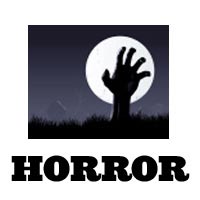 Horror Films are unsettling films
designed to frighten and panic, cause dread and alarm, and to invoke our hidden
worst fears, often in a terrifying, shocking finale, while captivating and
entertaining us at the same time in a cathartic experience. Horror films effectively
center on the dark side of life, the forbidden, and strange and alarming events.
They deal with our most primal nature and its fears: our nightmares, our vulnerability,
our alienation, our revulsions, our terror of the unknown, our fear of death
and dismemberment, loss of identity, or fear of sexuality. Horror Films are unsettling films
designed to frighten and panic, cause dread and alarm, and to invoke our hidden
worst fears, often in a terrifying, shocking finale, while captivating and
entertaining us at the same time in a cathartic experience. Horror films effectively
center on the dark side of life, the forbidden, and strange and alarming events.
They deal with our most primal nature and its fears: our nightmares, our vulnerability,
our alienation, our revulsions, our terror of the unknown, our fear of death
and dismemberment, loss of identity, or fear of sexuality.
Whatever dark, primitive, and revolting traits that
simultaneously attract and repel us are featured in the horror genre.
Horror films are often combined with science
fiction when the
menace or monster is related to a corruption of technology, or when
Earth is threatened by aliens. The fantasy and supernatural film
genres are not synonymous with the horror genre, although thriller
films may have some relation when they focus on the revolting
and horrible acts of the killer/madman. Horror films are also known
as chillers, scary movies, spookfests, and the macabre. See also Scariest
Film Moments and Scenes (illustrated) - from many of the
Greatest Horror Films ever made, Best
Film Death Scenes (illustrated), and Three Great Horror
Film Franchises.
Introduction to Horror Films Genre:
Horror films go back as far as the onset of films themselves,
over a 100 years ago. From our earliest days, we use our vivid imaginations
to see ghosts in shadowy shapes, to be emotionally connected to the unknown
and to fear things that are improbable. Watching a horror film gives an opening
into that scary world, into an outlet for the essence of fear itself, without
actually being in danger. Weird as it sounds, there's a very real thrill
and fun factor in being scared or watching disturbing, horrific images.
Horror films, when done well and with less reliance on horrifying
special effects, can be extremely potent film forms, tapping into our dream
states and the horror of the irrational and unknown, and the horror within
man himself. (The best horror films only imply or suggest the horror in subtle
ways, rather than blatantly displaying it, i.e., Val Lewton's horror films.)
In horror films, the irrational forces of chaos or horror invariably need
to be defeated, and often these films end with a return to normalcy and victory
over the monstrous.
Of necessity, the earliest horror films were Gothic in style
- meaning that they were usually set in spooky old mansions, castles, or fog-shrouded,
dark and shadowy locales. Their main characters have included "unknown," human,
supernatural or grotesque creatures, ranging from vampires, demented madmen,
devils, unfriendly ghosts, monsters, mad scientists, "Frankensteins," "Jekyll/Hyde"
dualities (good against evil), demons, zombies, evil spirits, arch fiends, Satanic villains, the
"possessed," werewolves and freaks to even the unseen, diabolical presence
of evil.
Horror films developed out of a number of sources: folktales
with devil characters, witchcraft, fables, myths, ghost stories, Grand
Guignol melodramas, and Gothic or Victorian novels from Europe by way
of Mary Shelley, Victor Hugo or Irish writer Bram Stoker, and American writers Robert Louis Stevenson and Edgar Allan Poe. Oscar Wilde's 1890 Faustian tale The Picture of Dorian Gray and H.G. Wells' 1896 story of The Island of Dr. Moreau were adapted into early film versions. In many
ways, the expressionistic German silent cinema led the world in films of horror
and the supernatural, and established its cinematic vocabulary and style. Many
of the early silent classics would be remade during the talkies era.
The Earliest Horror Films: Vampires (Vamps), Monsters, and
More
The vampire character has been one of the most ubiquitous
in the history of cinema, extending from the earliest days of cinema
to present-day manifestations. Dark, primitive, and revolting characters
that simultaneously attract and repel us formed the irresistible
heart of big-screen vampire tales. At first, bloodsuckers (leeches)
and vampire bats intrigued and frightened people from cultures around
the world. Demonic or supernatural possession was often juxtaposed with
blood-drinking, sex, and corpses. Many religions, myths, folk-tales and
cults espoused the idea of obtaining the life-essence from blood – in
its extreme was the practice of cannibalism.
Vampires began to emerge in popular fiction of the
18th and 19th centuries, during which time Anglo-Irish writer Bram
Stoker's 1897 vampire novel Dracula was written. It has
become the most popular, influential and preeminent source material
for many vampire films. Sheridan Le Fanu's 1872 lesbian vampire tale Carmilla came
a close second to Stoker's writings. Stoker's seminal book hatched
all the elements of future vampire films -- predatory female vamps
who kissed the neck of male victims for their human blood, an elderly
Count who vied for their prey, and a vampire hunter with garlic to
ward off the "Prince of Darkness" and with a wooden stake to drive through Dracula's heart.
The first horror movie, only about two minutes long,
was made by imaginative French filmmaker Georges Melies, titled Le
Manoir Du Diable (1896, Fr.) (aka The Devil's Castle/The Haunted
Castle) - containing familiar elements of later horror and vampire
films: a flying bat, a medieval castle, a cauldron, a demon figure
(Mephistopheles), and skeletons, ghosts, and witches - and a crucifix
to dispatch with evil. It appeared that Quasimodo, from Victor Hugo's Notre-Dame
de Paris 1831 novel, became the first horror figure in the 10-minute
short by female director Alice Guy titled Esmeralda (1905,
Fr.), and soon after was seen in the full-length horror
film Notre-Dame De Paris (1911, Fr.) (aka The Hunchback of
Notre Dame).
In the French silent film
serial (with ten chapters) Les Vampires (1915, Fr.)
(aka The Vampires) by director/writer Louis
Feuillade, subversive vampire thieves sucked the blood out of sleeping
bourgeois Parisian society, and stole their jewels. The villainous
leader of the vamps was Irma Vep (Musidora), an anagram for VAMPIRE.
The partly scripted, partly-improvised episodes (with eye-catching
titles like "The Severed Head" and "The Ring That
Kills")
followed investigative journalist Philippe Guérande
(Édouard Mathé) and his comic sidekick Oscar Mazamette
(Marcel Lévesque) in their continued attempts to foil The Vampire
Gang's elaborate schemes and gadgets.
 One
of the more memorable and influential of the early films was Germany's
silent expressionistic landmark classic, Das Kabinett des
Doktor Caligari (1919/1920, Ger.) (aka The Cabinet of Dr.
Caligari) from
director Robert Wiene, about a ghost-like hypnotist-therapist in
a carnival named Dr. Caligari (Werner Kraus) who calls pale-skinned,
lanky, black leotard-wearing Cesare (Conrad Veidt, later known for
his portrayal as Major Strasser in Casablanca
(1942)), his performing somnambulist (and haunted murderer),
from a state of sleep. The shadowy, disturbing, distorted, and dream-nightmarish
quality of the macabre and stylistic 'Caligari,' with twisted alleyways,
lopsided doors, cramped rooms, overhanging buildings, and skewed
cityscapes, was shot in a studio. It was brought to Hollywood in
the 1920s, and later influenced the classic period of horror films
in the 1930s - introducing many standard horror film conventions.
As with many classic films (i.e., Invasion
of the Body Snatchers (1956)), the original story was altered
(due to its insinuation that "authority" was questionable
and insane), and a flashback framing device (composed of an epilogue
and prologue) was added to soften its message. This made the film
appear to be a delusional nightmare in a psychotic mental patient's
(Francis) dream, thereby diluting the subversive nature of the
original. One
of the more memorable and influential of the early films was Germany's
silent expressionistic landmark classic, Das Kabinett des
Doktor Caligari (1919/1920, Ger.) (aka The Cabinet of Dr.
Caligari) from
director Robert Wiene, about a ghost-like hypnotist-therapist in
a carnival named Dr. Caligari (Werner Kraus) who calls pale-skinned,
lanky, black leotard-wearing Cesare (Conrad Veidt, later known for
his portrayal as Major Strasser in Casablanca
(1942)), his performing somnambulist (and haunted murderer),
from a state of sleep. The shadowy, disturbing, distorted, and dream-nightmarish
quality of the macabre and stylistic 'Caligari,' with twisted alleyways,
lopsided doors, cramped rooms, overhanging buildings, and skewed
cityscapes, was shot in a studio. It was brought to Hollywood in
the 1920s, and later influenced the classic period of horror films
in the 1930s - introducing many standard horror film conventions.
As with many classic films (i.e., Invasion
of the Body Snatchers (1956)), the original story was altered
(due to its insinuation that "authority" was questionable
and insane), and a flashback framing device (composed of an epilogue
and prologue) was added to soften its message. This made the film
appear to be a delusional nightmare in a psychotic mental patient's
(Francis) dream, thereby diluting the subversive nature of the
original.
Early Vampire Films:
Female vamps made an appearance in Robert Vignola's
melodramatic The Vampire (1913), although they were
femme fatales who seductively 'sucked' the life-blood from 'foolish'
men -- also exemplified by popular vamp actress Theda Bara in A
Fool There Was (1915). Allegedly, the
earliest significant vampire feature film (although a lost film) was
director Arthur Robison's German silent film Nachte
des Grauens (1916, Ger.) (aka Night of Horror)
featuring a strange, vampire-like character. [Note: Some sources
disagreed and described the vampire as a costumed ape-man ("Artist
kills all rivals in his role as ape man").] Until recently,
the lost Hungarian film Drakula
halala (1921, Hung.) (aka The Death of Dracula), was widely
assumed to be the first adaptation of Anglo-Irish writer Bram
Stoker's 1897 vampire novel Dracula, and featured cinema's
first Drakula.
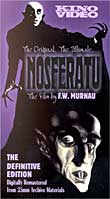 The first genuine vampire picture
was also produced by a European filmmaker - director F. W. Murnau's feature-length Nosferatu, A Symphony of Horror (1922, Ger.) (aka Nosferatu, eine Symphonie des
Grauens). Shot on location, it was an unauthorized film adaptation of Stoker's Dracula with Max Schreck in the title role as the screen's first vampire
- a mysterious aristocrat named Count Graf Orlok living in the late 1830s in the German town of Bremen. Because of copyright problems, the vampire
was named Nosferatu rather than Dracula, and the action was moved from Transylvania
to Bremen. The emaciated, balding, undead vampire's image was unforgettable
with a devil-rat face, pointy ears, elongated fingers, sunken cheeks, and
long fangs, with plague rats following him wherever he went. In the film's
conclusion, the grotesque, cadaverous creature was tricked by the heroine Nina
(Greta Schroder) into remaining past daybreak, so Orlok met his fate by
disintegrating into smoke in the sunlight. The first genuine vampire picture
was also produced by a European filmmaker - director F. W. Murnau's feature-length Nosferatu, A Symphony of Horror (1922, Ger.) (aka Nosferatu, eine Symphonie des
Grauens). Shot on location, it was an unauthorized film adaptation of Stoker's Dracula with Max Schreck in the title role as the screen's first vampire
- a mysterious aristocrat named Count Graf Orlok living in the late 1830s in the German town of Bremen. Because of copyright problems, the vampire
was named Nosferatu rather than Dracula, and the action was moved from Transylvania
to Bremen. The emaciated, balding, undead vampire's image was unforgettable
with a devil-rat face, pointy ears, elongated fingers, sunken cheeks, and
long fangs, with plague rats following him wherever he went. In the film's
conclusion, the grotesque, cadaverous creature was tricked by the heroine Nina
(Greta Schroder) into remaining past daybreak, so Orlok met his fate by
disintegrating into smoke in the sunlight.
[Note: There were many attempts to copy or remake the film. German
director Werner Herzog's faithful shot-by-shot color remake Nosferatu the Vampyre (1979) starred Klaus Kinski as the nauseating Count Dracula and beautiful Isabelle Adjani as Lucy Harker. Producer/director Augusto Caminito's sequel was Vampire in Venice (1988, It.) (aka Nosferatu a Venezia) with Kinski as Nosferatu and Christopher Plummer as inept vampire hunter Professor Paris Catalano. At the turn of the century, Shadow of the Vampire
(2000) fancifully retold the making of the 1922 classic, with John Malkovich
as obsessive director F.W. Murnau. It asked the question: "What if
Max Schreck (Oscar-nominated Willem Dafoe), who played the character of
Count Orlok, was indeed a vampire?"]
Early Monster (Frankenstein) Films:
 In
Danish director Stellan Rye's and Paul Wegener's early German silent horror film Der Student
von Prag (1913, Ger.) (aka The Student of Prague/A Bargain With Satan), based loosely upon the Faust legend,
a poor student made a pact with the devil in return for wealth and a beautiful
woman. [The student was portrayed by actor/producer/director Paul Wegener in his film
debut.] It was the first artistically important German production - and was
later remade in 1926 and directed by Henrik Galeen. Wegener directed the first
of his influential adaptations of the Golem legend by Gustav Meyrinck - Der
Golem (1914, Ger.) (aka The Monster of Fate), and then remade it a few years
later as Der Golem Und Die Tanzerin (1917, Ger.) (aka The Golem and the Dancer) - notably the first horror film sequel. He remade the film a third time,
with Karl Freund as cinematographer, again titling it Der Golem (1920, Ger.)
(aka The Golem: or How He Came Into the World). The expressionistic film
was based upon Central European myths and influenced later 'Frankenstein'
monster films in the early 1930s with themes of a creator losing control of
his creation. The Golem, played by Wegener, was an ancient clay figure from
Hebrew mythology that was brought to life by Rabbi Loew's magic amulet to
defend and save the Jews from a pogrom in the 16th century threatened by Rudolf II of Habsburg.
The man-made, clay creature roamed through the Jewish ghetto of medieval Prague to protect it from persecution. In
Danish director Stellan Rye's and Paul Wegener's early German silent horror film Der Student
von Prag (1913, Ger.) (aka The Student of Prague/A Bargain With Satan), based loosely upon the Faust legend,
a poor student made a pact with the devil in return for wealth and a beautiful
woman. [The student was portrayed by actor/producer/director Paul Wegener in his film
debut.] It was the first artistically important German production - and was
later remade in 1926 and directed by Henrik Galeen. Wegener directed the first
of his influential adaptations of the Golem legend by Gustav Meyrinck - Der
Golem (1914, Ger.) (aka The Monster of Fate), and then remade it a few years
later as Der Golem Und Die Tanzerin (1917, Ger.) (aka The Golem and the Dancer) - notably the first horror film sequel. He remade the film a third time,
with Karl Freund as cinematographer, again titling it Der Golem (1920, Ger.)
(aka The Golem: or How He Came Into the World). The expressionistic film
was based upon Central European myths and influenced later 'Frankenstein'
monster films in the early 1930s with themes of a creator losing control of
his creation. The Golem, played by Wegener, was an ancient clay figure from
Hebrew mythology that was brought to life by Rabbi Loew's magic amulet to
defend and save the Jews from a pogrom in the 16th century threatened by Rudolf II of Habsburg.
The man-made, clay creature roamed through the Jewish ghetto of medieval Prague to protect it from persecution.
The earliest horror pictures were one-reel or full length features,
many of which were produced in the US from 1909 to the early 1920s, making the horror genre
one of the oldest and most basic. Many of them are now-forgotten "vamp" pictures (featuring devilish, captivating ladies). The first Frankenstein monster film in the
US was Frankenstein (1910) by director J. Searle Dawley, a 16-minute (one-reel) version made
by the Edison Studios and starring Charles Ogle as the monster. In this early
version, the Monster was created in a cauldron of chemicals rather than by a bolt of lightning. Two other silent
precursors to later Frankenstein films were Joseph W. Smiley's Life Without Soul (1915) and the expressionistic German film Homunculus (1916), a six-hour epic serial about
an artificially-created man. Before the 1930s, Hollywood was reluctant to
experiment with the themes of true horror films. Instead, the studios took
popular stage plays and emphasized their mystery genre features, providing
rational explanations for all the supernatural and occult elements.
The Miser's Conversion (1914) (aka The Miser's Reversion) was the first film to depict a screen transformation by using a series of dissolves with footage of the character's different stages of makeup, rather than a single jump-cut. This was later used to great effect in many films including Dr. Jekyll and Mr. Hyde (1931) and The Wolf Man (1941). In the film, the title character miser (Sidney Bracey), 75 year-old John Grisley, obsessed with the idea of evolution, acquired a rejuvenation serum that transformed him into a 40 year-old man with just a few drops. To intensify the effect, he drank the entire bottle of serum and reverted into an ape.
Man of a Thousand Faces - Lon Chaney: The First
American Horror Film Star
One
actor who helped pave the way for the change in outlook and acceptance of
the horror genre was Lon (Alonso) Chaney, Sr., known as "the man of a thousand
faces" because of his transformative, grotesque makeup and acting genius as a pantomime artist.
He appeared in numerous
silent horror films beginning in 1913 at Universal Studios. He was soon to become the first American horror-film star and Hollywood's first great character actor. His first grotesque character role as a fake cripple (a contorted figure named the Frog), his breakthrough role, was in The Miracle Man (1919) (a film that only partially survives). Chaney's films, collaborating with director Tod Browning on ten feature films over a decade, included these examples of lurid melodrama (and horror) and crime:
- Universal's The Wicked Darling (1919) - Chaney's first film partnering with Tod Browning, portraying a thief named Stoop Connors
- Universal's Outside the Law (1920) - a crime drama with Chaney in a dual supporting role as Black Mike Sylva and Ah Wing
- MGM's The Unholy Three (1925) - with Chaney as a criminal ventriloquist named Professor Echo; it was later remade by MGM in 1930 by director Jack Conway (again with Chaney) - it was Chaney's first and only talkie before he died of throat cancer
- MGM's The Blackbird (1926) - Chaney portrayed the dual roles of Dan 'The Blackbird' and The Bishop
- MGM's The Road to Mandalay (1926) - Chaney took the role of Singapore Joe
- MGM's London After Midnight (1927) -
Browning's first Hollywood vampire film (a lost film) in which
Chaney starred as a sunken and dark-eyed vampirish character
- MGM's The Unknown (1927) - Chaney portrayed Alonzo the Armless Knife-thrower, a circus performer, with an obsession for a carnival girl (Joan Crawford in an early role) in its tale of a love-triangle
- MGM's West of Zanzibar (1928) - Chaney was cast as English magician named Phroso, now crippled and bald-headed and known as 'Dead-Legs' in "A Story of Love and Revenge in African Jungles!"
- MGM's The Big City (1928), a lost film
- MGM's Where East is East (1929) - the last collaboration between Browning and Chaney (a film that only partially survives); Chaney starred as Indochinese animal trapper "Tiger" Haynes
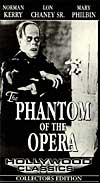 In the first of Chaney's two other horror masterpieces,
he appeared in one of the earliest versions of Victor Hugo's novel about the hunchbacked
Quasimodo - a tortured bellringer living in a cathedral tower in love with gypsy dancer Esmeralda (Patsy Ruth Miller) in director Wallace Worsley's The Hunchback of Notre Dame (1923) - it was another silent film version of the
classic tale. [An earlier version was The Darling of Paris (1917), a lost film starring
vamp Theda Bara as Esmeralda.] In the first of Chaney's two other horror masterpieces,
he appeared in one of the earliest versions of Victor Hugo's novel about the hunchbacked
Quasimodo - a tortured bellringer living in a cathedral tower in love with gypsy dancer Esmeralda (Patsy Ruth Miller) in director Wallace Worsley's The Hunchback of Notre Dame (1923) - it was another silent film version of the
classic tale. [An earlier version was The Darling of Paris (1917), a lost film starring
vamp Theda Bara as Esmeralda.]
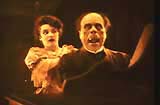 Chaney's
most memorable portrayal was in the ground-breaking, vividly-frightening,
Beauty-and-the-Beast silent film, Rupert Julian's costume horror classic The
Phantom of the Opera (1925), as Devil's Island escapee Erik - a disfigured,
deranged, bitter and vengeful composer/ghost of the Paris Opera (based on
the character in Gaston Leroux's 1911 novel). This film was a technical achievement,
with a two-color Technicolor 'Bal Masque' sequence, the falling chandelier
and underground lake scenes. Its dark expressionistic tones helped set the
tone for horror films in the 30s. Its most famous scene was ingenue Christine's
(Mary Philbin) unmasking of Lon Chaney's mask - revealing a hideous skull-face,
lipless mouth, rotten teeth, snouty nose, and bulging eyes. Chaney's
most memorable portrayal was in the ground-breaking, vividly-frightening,
Beauty-and-the-Beast silent film, Rupert Julian's costume horror classic The
Phantom of the Opera (1925), as Devil's Island escapee Erik - a disfigured,
deranged, bitter and vengeful composer/ghost of the Paris Opera (based on
the character in Gaston Leroux's 1911 novel). This film was a technical achievement,
with a two-color Technicolor 'Bal Masque' sequence, the falling chandelier
and underground lake scenes. Its dark expressionistic tones helped set the
tone for horror films in the 30s. Its most famous scene was ingenue Christine's
(Mary Philbin) unmasking of Lon Chaney's mask - revealing a hideous skull-face,
lipless mouth, rotten teeth, snouty nose, and bulging eyes.
[Other versions
over the years are wide-ranging, as both horror films and theatrical musicals]:
- The Phantom of the Opera (1943), d. Arthur Lubin,
Universal's Technicolored version with Claude Rains as the title character
- a disfigured violinist, and also Nelson Eddy as Raoul, the Phantom's rival
for Christine's (Susanna Foster) love
- The Phantom of the Opera (1962), d. Terence Fisher,
with Herbert Lom (of Pink Panther fame) in a UK Hammer Films production
as Professor Petrie/the Phantom and Heather Sears as Christine Charles
- The Phantom of the Paradise (1974), d. Brian DePalma,
a rock-opera musical version (and cult favorite) starring Paul Williams
as a Svengali impresario named the Swan
- The Phantom of the Opera (1983), d. Robert Markowitz,
a made-for-TV movie starring a miscast Jane Seymour and Maximilian Schell
as the Phantom, set in Budapest
- The Phantom of the Opera (1986), the long-running
Andrew Lloyd Webber theatrical musical show, featuring Sarah Brightman
- The Phantom of the Opera (1989), d. Dwight H. Little,
with Robert Englund (horror movie villain Freddy Krueger in the Nightmare
on Elm Street series) as the Phantom and Jill Schoelen as Christine
- The Phantom of the Opera (1990), d. Tony Richardson,
a two-part NBC-TV mini-series, with Burt Lancaster starring as the Baron
- the Phantom's father (in one of his final film appearances), Teri Polo
as Christine, and Charles Dance as the Phantom
- The Phantom of the Opera (1991), d. Darwin Knight,
a theatrical musical created by Maury Yeston and Arthur Kopil and filmed
before a live audience, starring David Staller and Elizabeth Walsh
- Il Fantasma Dell'Opera (1998, It.) (aka The Phantom
of the Opera), d. Dario Argento, a loose adaptation with daughter Asia
Argento as Christine and Julian Sands as the nameless Phantom (without a
mask); with great production values including more sex, graphically-bloody
gore, and a musical score by Ennio Morricone
- The Phantom of the Opera (2004), d. Joel Schumacher,
with Gerard Butler as the lead character, and starlet Emmy Rossum (a trained
opera singer) as Christine; also with Minnie Driver and Miranda Richardson
[James Cagney played the role of Chaney
in Man of a Thousand Faces (1957) and recreated the star's roles as
the Phantom and Quasimodo in two of horror's greatest achievements.]
The Cycle of Dr. Jekyll and Mr. Hyde Films:
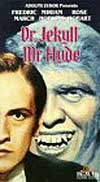 There were a few very early renditions in the 1900s of the classic tale taken from Robert Louis
Stevenson's story "The Strange Case of Dr. Jekyll and Mr. Hyde" (and Thomas Russell Sullivan's 1887 stage play "Dr. Jekyll and Mr. Hyde") about a doctor/scientist whose evil side was brought out
by a magic formula. The first filmed version was also the first American horror film - director Otis Turner's Dr. Jekyll and Mr. Hyde (1908) with Hobart Bosworth in the lead role - by the Selig Polyscope Corporation. The next was Thanhouser Film Corporation's (New York) one-reel Dr. Jekyll and Mr. Hyde (1912) with future director James Cruze starring as the title character. And then superstar King Baggot appeared in independent IMP's (the future Universal Studios) two-reeler Dr. Jekyll and Mr. Hyde (1913). Broadway idol John Barrymore also starred in one of the earliest versions of the Jekyll/Hyde story, a silent
film from Famous Players-Lasky Corporation titled Dr. Jekyll and Mr. Hyde (1920). [Another almost forgotten version in 1920 from the Pioneer Film Corporation starred Sheldon Lewis.] The familiar story was later re-made in many versions, but the two most
noteworthy versions were: There were a few very early renditions in the 1900s of the classic tale taken from Robert Louis
Stevenson's story "The Strange Case of Dr. Jekyll and Mr. Hyde" (and Thomas Russell Sullivan's 1887 stage play "Dr. Jekyll and Mr. Hyde") about a doctor/scientist whose evil side was brought out
by a magic formula. The first filmed version was also the first American horror film - director Otis Turner's Dr. Jekyll and Mr. Hyde (1908) with Hobart Bosworth in the lead role - by the Selig Polyscope Corporation. The next was Thanhouser Film Corporation's (New York) one-reel Dr. Jekyll and Mr. Hyde (1912) with future director James Cruze starring as the title character. And then superstar King Baggot appeared in independent IMP's (the future Universal Studios) two-reeler Dr. Jekyll and Mr. Hyde (1913). Broadway idol John Barrymore also starred in one of the earliest versions of the Jekyll/Hyde story, a silent
film from Famous Players-Lasky Corporation titled Dr. Jekyll and Mr. Hyde (1920). [Another almost forgotten version in 1920 from the Pioneer Film Corporation starred Sheldon Lewis.] The familiar story was later re-made in many versions, but the two most
noteworthy versions were:
- director Rouben Mamoulian's first sound version Dr.
Jekyll and Mr. Hyde (1931), starring Fredric March in the title
role as the villainous scientist (the first Oscar-winning horror performance) and Miriam Hopkins as the slutty Cockney barmaid Ivy. The film had ground-breaking transformative special effects as March changed from Jekyll into Hyde, filmed in one-take
- Victor Fleming's
ponderous MGM production (which won the Academy Award for black and white cinematography) Dr. Jekyll and Mr. Hyde (1941), starring Spencer Tracy in the title
role and Ingrid Bergman as the "wicked" prostitute
[In the psycho-sexual
thriller Mary Reilly (1995), Julia Roberts starred as the innocent
maid of the infamous Dr. Jekyll to provide a new perspective.]
The Advent of Classic Horror Films of the 30s: The End of Silent Horror Films, The Rise of Universal
Studios
Actor Conrad Veidt and German expressionistic director Paul
Leni were recruited by Universal's boss Carl Laemmle in the mid-1920s. Paul
Leni was already known in his homeland for the spooky horror classics Backstairs
(1921, Ger.) (aka Hintertreppe) and the expressionistic anthology Waxworks (1924, Ger.) (aka Das Wachsfigurenkabinett). After moving to Hollywood, Leni directed The Cat and the Canary (1927), a derivative from a stage-bound 1922
melodrama. The influential film is considered the first Gothic 'haunted house'
horror film. Veidt was cast as an ever-smiling, grotesque carnival freak named
Gwynplaine in Leni's next film for Universal, The Man Who Laughs (1927),
a superb romantic melodrama.
The first talkie horror film was also the second 'all-talking' motion picture from Warner Bros -- director Roy Del Ruth's The Terror (1928), a stage-bound adaptation of Edgar Wallace's play regarding a haunted house terrorized by a homicidal asylum escapee. The film's many ads capitalized on the new feature of sound (creaking doors, howling wind, organ music), heard with the Vitaphone sound-on-disc process: "It will thrill you! Grip you! Set you into tremors of awe. HEAR this creepy tale of mystery - the baffling story of a detective's great triumph. With voices and shadows that will rack your nerves and make you like it. Come, hear them talk in this Vitaphone production of the play that has gripped London for over 3 years."
By the early 1930s, horror entered into its classic phase
in Hollywood - the true Dracula and Frankenstein Eras, with
films that borrowed from their German expressionism roots. The studios took
morbid tales of European vampires and undead aristocrats, mad scientists,
and invisible men and created some of the most archetypal creatures and monsters
ever known for the screen. Universal Studios, with many groundbreaking silent horror films, continued its tradition by providing talkie horror films derived from literature and other mythic-legendary sources. It was best-known for its pure horror
films in the 30s and 40s, horror-dom's characters (Frankenstein, Dracula,
The Mummy, the Invisible Man, and the Wolf Man) and its classic horror stars,
Hungarian matinee idol Bela Lugosi and Boris Karloff.
The First of the Dracula Films:
 According
to Guinness World Records, the character most frequently
portrayed in horror films has been Dracula, with nearly 200 representations
(at the present count). With Tod Browning's direction, Universal
Studios produced a film version of Lugosi's 1927 Broadway stage
success about a blood-sucking, menacing vampire named Dracula
(1931), released early in the
year. [Lon Chaney, Sr. was one of many actors considered to play the
title character, but he died in 1930.] The atmospheric, commercially-successful
film adaptation of Bram Stoker's novel played upon fears of sexuality,
blood, and the nebulous period between life and death. The heavily-accented
voice and acting of Hungarian actor Bela Lugosi in his most famous
portrayal as the 500 year old vampire was elegant, suave, exotic
and stylish - and frightening to early audiences - while the undead
villain hypnotically charmed his victims with a predatory gaze. According
to Guinness World Records, the character most frequently
portrayed in horror films has been Dracula, with nearly 200 representations
(at the present count). With Tod Browning's direction, Universal
Studios produced a film version of Lugosi's 1927 Broadway stage
success about a blood-sucking, menacing vampire named Dracula
(1931), released early in the
year. [Lon Chaney, Sr. was one of many actors considered to play the
title character, but he died in 1930.] The atmospheric, commercially-successful
film adaptation of Bram Stoker's novel played upon fears of sexuality,
blood, and the nebulous period between life and death. The heavily-accented
voice and acting of Hungarian actor Bela Lugosi in his most famous
portrayal as the 500 year old vampire was elegant, suave, exotic
and stylish - and frightening to early audiences - while the undead
villain hypnotically charmed his victims with a predatory gaze.
- [An impressive-looking Spanish version, with director George
Melford in place of Browning, was shot simultaneously on the same sets at
night, but with a different cast and crew (Carlos Villarías replaced
Lugosi, and Eduardo Arozamena as Van Helsing, along with provocatively-dressed
actresses Lupita Tovar as Eva (Mina) and Carmen Guerrero as Lucia (Lucy)).]
- [In director Tim Burton's horror/comedy Ed Wood (1994),
Martin Landau won a Best Supporting Actor Oscar as the aging, morphine-addicted
horror star Bela Lugosi, a friend of one of Hollywood's worst directors.]
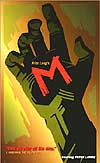 In
the same year, Danish writer/director Carl Theodor Dreyer's dreamlike,
atmospheric, seminal horror film Vampyr (1931, Ger./Fr.)
(aka Not Against the Flesh/Castle of Doom) was released.
The unsettling film, Dreyer's first sound feature, was loosely based
on the 1872 lesbian vampire short story Carmilla by J. Sheridan
Le Fanu. It was alternatively titled The Strange Adventure of
David Grey -
and it told the story of an occult researcher named Allan/David Grey
(Baron Nicolas de Gunsburg, played by Julian West) in a remote country
inn in the village of Courtempierre who was given a vampire combat
book. He slowly believed he was surrounded by vampires - and dreamt
of his own death and glass-lidded coffin burial (filmed with
a double-exposure) during a blood-loss induced fever dream. In
the same year, Danish writer/director Carl Theodor Dreyer's dreamlike,
atmospheric, seminal horror film Vampyr (1931, Ger./Fr.)
(aka Not Against the Flesh/Castle of Doom) was released.
The unsettling film, Dreyer's first sound feature, was loosely based
on the 1872 lesbian vampire short story Carmilla by J. Sheridan
Le Fanu. It was alternatively titled The Strange Adventure of
David Grey -
and it told the story of an occult researcher named Allan/David Grey
(Baron Nicolas de Gunsburg, played by Julian West) in a remote country
inn in the village of Courtempierre who was given a vampire combat
book. He slowly believed he was surrounded by vampires - and dreamt
of his own death and glass-lidded coffin burial (filmed with
a double-exposure) during a blood-loss induced fever dream.
And Fritz Lang's M (1931, Ger.) introduced
a terrorized criminal, child-murdering deviant character (portrayed
by German-born Peter Lorre in his mesmerizing film debut) who was
based on the real-life, notorious serial killer Peter Kurten - the
'Vampire of Dusseldorf.' In his defining performance, Lorre cried
out that he couldn't help his compulsion. [Peter Lorre's first American
role was in cinematographer/director Karl Freund's melodramatic horror
film Mad Love (1935), an adaptation of Maurice Renard's
1920 novel Les Mains d'Orlac about
an obsessed and twisted surgeon named Dr. Gogol who schemed to win
the love of Parisian Grand Guignol theatre actress Yvonne Orlac (Frances
Drake) by transplanting the hands of a knife-murderer onto her injured
concert pianist husband Stephen Orlac (Colin Clive).]
The Original Frankenstein Film:
 The
first Dracula film was followed closely by the definitive, quintessential
combination of science fiction and Gothic horror in a 'mad doctor' thriller.
This classic monster/horror film - Frankenstein (1931) - was James Whale's adaptation from Mary Shelley's novel about Dr. Henry Frankenstein
with a virtually unknown actor - Boris Karloff. With a boxy forehead and neck
electrodes (and other features created from Whale's sketches by make-up artist
Jack Pierce), Karloff's poignant portrayal of the pathetic created Monster's
plight gave a personality to the outcast, uncomprehending character with a
lumbering and lurching gait. The
first Dracula film was followed closely by the definitive, quintessential
combination of science fiction and Gothic horror in a 'mad doctor' thriller.
This classic monster/horror film - Frankenstein (1931) - was James Whale's adaptation from Mary Shelley's novel about Dr. Henry Frankenstein
with a virtually unknown actor - Boris Karloff. With a boxy forehead and neck
electrodes (and other features created from Whale's sketches by make-up artist
Jack Pierce), Karloff's poignant portrayal of the pathetic created Monster's
plight gave a personality to the outcast, uncomprehending character with a
lumbering and lurching gait.
The next three films in the series (see later) were:
The Wolf Man Cycle of Films:
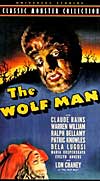 Without
resorting to an existing literary horror figure, such as Frankenstein, Dracula,
Dr. Jekyll and Mr. Hyde, or The Invisible Man, Universal also created a new
and 'original' creature in two films - the werewolf - the last of its great
original horror characters. The first US werewolf film was Stuart Walker's
well-made The Werewolf of London (1935) with Henry Hull as Dr. Glendon
- the scientist who brought the 'wolf' curse upon himself. The second, most
famous and definitive Wolf Man character was in director George Waggner's
excellent B-grade film, The Wolf Man (1941) with Lon Chaney, Jr. in
his first appearance as the accursed Larry Talbot - his portrayal came
to be his best-known role. The "transformation" scene from man-to-wolf, involving
complicated cosmetic/makeup artistry, was remarkably realistic. [The makeup
artist used yak hair and a rubber snout.] Without
resorting to an existing literary horror figure, such as Frankenstein, Dracula,
Dr. Jekyll and Mr. Hyde, or The Invisible Man, Universal also created a new
and 'original' creature in two films - the werewolf - the last of its great
original horror characters. The first US werewolf film was Stuart Walker's
well-made The Werewolf of London (1935) with Henry Hull as Dr. Glendon
- the scientist who brought the 'wolf' curse upon himself. The second, most
famous and definitive Wolf Man character was in director George Waggner's
excellent B-grade film, The Wolf Man (1941) with Lon Chaney, Jr. in
his first appearance as the accursed Larry Talbot - his portrayal came
to be his best-known role. The "transformation" scene from man-to-wolf, involving
complicated cosmetic/makeup artistry, was remarkably realistic. [The makeup
artist used yak hair and a rubber snout.]
Unfortunately, the Wolf Man role hopelessly typecast Chaney,
Jr. for life. In fact, he was the only actor to play all four classic movie monsters: the Wolf Man, the Frankenstein monster (in The Ghost of Frankenstein (1942)), Kharis (the Mummy) (in The Mummy's Tomb (1942), The Mummy's Ghost (1944) and The Mummy's Curse (1944)), and Count Dracula (in Son of Dracula (1943)).
He was forced to star in a series of very poor sequels, teamed
up with other Universal horror stars in B-grade films including Frankenstein
Meets the Wolfman (1943) (in which Chaney, Jr. portrayed the Wolf Man and Lugosi was the Frankenstein Monster), and in two films adding Dracula to the mix:
- House of Frankenstein (1944) (the first all-star
get-together with Glenn Strange as the Frankenstein Monster, John Carradine as Baron
Dracula, Boris Karloff as mad scientist Dr. Gustav Neimann, and Lon Chaney, Jr. as Larry Talbot/the Wolf
Man)
- House of Dracula (1945) - an immediate sequel to
the House of Frankenstein (1944) film, with Lon Chaney, Jr. as the
Wolf Man, John Carradine as Dracula, and Glenn Strange as the Frankenstein Monster - again
The worst ignominy suffered by Chaney, Jr. was in Universal-International's
hybrid horror-comedy Abbott and Costello Meet Frankenstein (1948) with the two screen
comedians. Here was evidence that classic horror films in the genre were beginning
to go out of style after the real 'horrors' of World War II, and Universal
was attempting to crank out more and more sequels for younger audiences.
Another unrelated 'wolf-man'
film was She-Wolf of London (1946), with June Lockart as Phyllis Allenby,
an innocent young girl in London - and the alleged perpetrator of gruesome
murders. |
